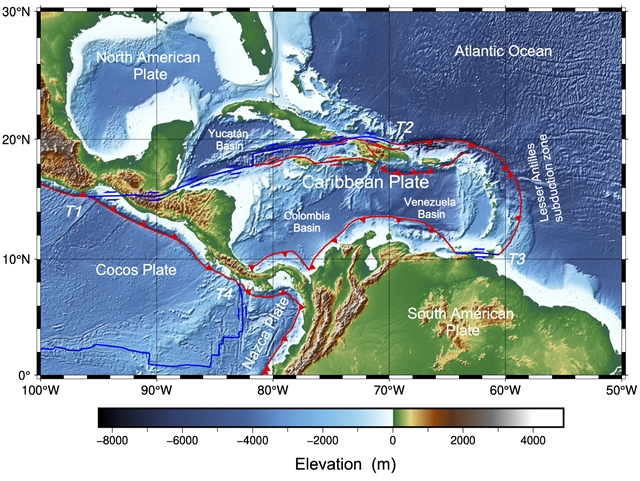
中国科学院地质与地球物理研究所赵亮团队近日研究了中新生代加勒比海俯冲体系的深部过程与表面效应。相关论文于2025年6月18日发表在《中国科学:地球科学》杂志上。
穿过地球内部和表面球体的物质和能量循环是地球科学研究的前沿热点,定量动力学模型是分析多层相互作用的基础。自中新生代以来,加勒比海及其邻近地区一直夹在太平洋俯冲和大西洋伸展系统之间,经历了大规模的海洋俯冲、板块边界重塑、板块撕裂和大规模岩浆事件。这些构造过程改变了陆地和海洋的分布,创造了动态地形,改变了地表航道的开合、海洋环流、风化和沉积模式,并进一步影响了区域盆地的演化。因此,加勒比海及其邻近地区是研究多层相互作用的理想场所。
在多层相互作用的背景下,中新生代加勒比海地区的驱动因素是什么? 它们是如何引发表面效应的?为了解决这些关键问题,研究组首次重建了加勒比地区时变俯冲板块下沉速率模型和俯冲板块通量曲线,提供了一个一阶运动学模型。这意味着中生代晚期和新生代早期是区域俯冲最强烈、俯冲碳通量最高的时期。基于运动学模型,采用进一步的动力学模拟来计算新生代以来俯冲过程引起的陆海分布和动态地形变化。结果表明,太平洋板块俯冲引起的高浮力地形和东西向动态地形变化是主要特征,可以很好地解释区域壳幔地球物理观测。
因此,从动力学过程的角度来看,这些发现证实了新生代以来多俯冲系统的深部过程控制了该地区的陆海分布和地形演变等地表效应。基于动态模型,研究组同化了地表沉积层分布数据。他们建议进行三维内表面碳循环模拟,作为定量评估区域深层过程如何影响未来表面演化的动态框架。这将进一步整合古气候、洋流、风化和沉积模块,以定量模拟盆地中油气资源的富集过程。这代表了多层相互作用下油气富集理论应用研究的一个新方向。
附:英文原文
Title: Deep processes and surface effects of the Meso-Cenozoic Caribbean subduction system
Author: Liang ZHAO, Rixiang ZHU, Hao SHEN, Shaohui LIU, Jianfeng YANG, Huajian WANG, Wang ZHANG, Baolu SUN
Issue&Volume: 2025/06/18
Abstract: The material and energy cycle crossing Earth’s interior and surface spheres is a cutting-edge hotspot in Earth science research, and a quantitative dynamic model serves as the foundation for analyzing multi-spheric interactions. Since the Meso-Cenozoic, the Caribbean and its adjacent regions have been sandwiched between the Pacific subduction and Atlantic extension systems, experiencing large-scale oceanic subduction, plate boundary reshaping, slab tearing, and massive magmatic events. These tectonic processes have modified the distribution of land and sea, created dynamic topography, altered the opening and closing of surface seaways, ocean circulation, weathering, and sedimentation patterns, and further influenced regional basin evolution. Thus, the Caribbean and its adjacent regions are ideal sites for studying multi-spheric interactions. In the context of multi-spheric interactions, what are the driving factors in the Meso-Cenozoic Caribbean region How do they trigger surface effects To address these key questions, this study reconstructs, for the first time, a time-varying subduction slab sinking rate model and subduction slab flux curve for the Caribbean region, providing a first-order kinematic model. It implies that the late Mesozoic and early Cenozoic were periods of the most intense regional subduction and the highest subduction carbon flux. Based on the kinematic model, further dynamic simulations are employed to calculate the land-sea distribution and dynamic topography changes induced by subduction processes since the Cenozoic. The results suggest that the high-buoyancy topography and east-west-aligned dynamic topography variations caused by Pacific plate subduction are primary features, which can well explain regional crust-mantle geophysical observations. These findings thus validate, from a dynamic process perspective, that the deep processes of multi-subduction systems since the Cenozoic have controlled surface effects such as land-sea distribution and topographic evolution in this region. Building on the dynamic model, this study assimilates surface sedimentary layer distribution data. We propose conducting three-dimensional interior-surface carbon cycle simulations as a dynamic framework for quantitatively assessing how regional deep processes influence surface evolution in the future. This would further merge paleoclimate, ocean currents, weathering, and sedimentation modules to simulate the enrichment processes of hydrocarbon resources in basins quantitatively. This represents a new direction in applied research on hydrocarbon enrichment theory under multi-spheric interactions.
DOI: 10.1007/s11430-024-1595-2
Source: https://www.sciengine.com/10.1007/s11430-024-1595-2
Science China Earth Sciences:《中国科学:地球科学》,创刊于1952年。隶属于施普林格·自然出版集团,最新IF:5.7
官方网址:https://www.sciengine.com/SCES/home
投稿链接:https://mc03.manuscriptcentral.com/sces
